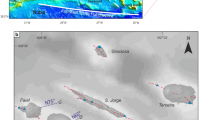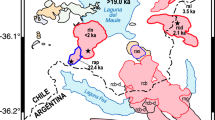Abstract
This article deals with the results of the study of primary melt inclusions in clinopyroxene megacrysts and phenocrysts from haüyne foidite of SVSl lava flow of the Vulture–San Michele subsyntheme of Vulture Volcano (Italy). The considered rock consists of megacrysts and numerous homogeneous and zoned phenocrysts of clinopyroxene, rare grains of plagioclase, phlogopite, haüyne, analcime, leucite, apatite, magnetite, and glass. The chemical composition of the clinopyroxene corresponds to diopside according to Morimoto classification (1989). The clinopyroxene-hosted melt inclusions are homogenized at 1200–1190°C in megacrysts, and at 1190–1170°C in phenocrysts, and have K-rich and Na-rich basic composition. At relatively close amount of alumina and MgO/(MgO+FeO) ratio, the Na-melt has higher contents of Mg, Ca, Fe, Ti, Mn, Cl and SO3 and lower Ba and water compared to K-melt. Both types of the alkaline basic melts are enriched in incompatible elements, the content of which are over 1–2 orders of magnitude higher than the mantle values, and the Na-melt is more enriched than the K-melt. The high amount of incompatible components in the melts and some HREE depletion relative to LREE indicate an involvement of undepleted mantle in magma generation. The Na-rich and K-rich melts conserved in clinopyroxene-hosted inclusions differ in Ta/Nb, Th/Yb, La/Nb, Y/Nb, Zr/Nb, Ti/Zr, and Ti/Y indicator ratios, which indicates different composition of parental magmas, different mantle sources, and different degrees of their melting. It is concluded that the considered haüyne foidite is formed by mixing of Na-rich and K-rich basic melts, which were derived from different parental magmas and different mantle sources.









Similar content being viewed by others
REFERENCES
Yu. A. Balashov, Rare-Earth Element Geochemistry (Nauka, Moscow, 1976) [in Russian]. T. Yu. Bazarova, I. T. Bakumenko, V. P. Kostyuk, L. I. Panina, V. S. Sobolev, and A. I. Chepurov, Magmatogenic Crystallization: Evidence from Melt Inclusion Study (Nauka, Novosibirsk, 1975) [in Russian].
L. Becculava, M. Coltorti, P. Di Girolamo, L. Melluso, L. Milani, V. Morra, and F. Siena, “Petrogenesis and evolution of Mt. Vulture alkaline volcanism (Southern Italy),” Mineral. Petrol. 74, 277–297 (2002).
K. Bell, “Radiogenic isotope constraints on relationships between carbonatites and associated rocks: a brief review,” J. Petrol. 39, 1987–1996 (1998).
K. Bell, F. Castorina, G. Rosatelli, and F. Stoppa, “Plume activity, magmatism, and the geodynamic evolution of the Central Mediterranean,” Ann. Geophys. 49 (1), 357–369 (2006).
A. Caggianelli, M. De Fino, L. La Volpe, and G. Piccarretta, “Mineral chemistry of Monte Vulture volcanics: petrological inferences,” Mineral. Petrol. 41, 215–227 (1990).
F. Castorina, F. Stoppa, A. Cundari, and M. Barbieri, “An enriched mantle source for Italy’s melilitite—carbonatite association as inferred by its Nd–Sr isotope signature,” Mineral. Mag. 64, 625–640 (2000).
G. Cavarretta and G. Lombardi “Origin of sulphur in the Quaternary perpotassic melts from Italy: evidence from hauyne sulphur isotope data,” Chem. Geol. 82, 15–20 (1990).
R. L. Cullers and J. L. Craf, “Rare earth elements in igneous rocks of the continental crust: predominantly basic and ultrabasic rocks,” Kimberlites, Part 7.2. Rare Earth Elements Geochemistry (Elsevier, 1984), Vol. 2, pp. 239–243 (1984).
G. De Astis, P. D. Kempton, A. Peccerillo, and T. W. Wu, “Trace element and isotopic variations from Mt. Vulture to Campanian volcanoes: constraints for slab detachment and mantle inflow beneath southern Italy,” Contrib. Mineral. Petrol. 151, 331–351 (2006).
M. De Fino, L. La Volpe, A. Peccerilo, G. Piccarreta, and G. Poli, “Petrogenesis of Monte Vulture volcano (Italy): inferences from mineral chemistry, major and trace element data,” Contrib. Mineral. Petrol. 92, 135–145 (1986).
N. L. Dobretsov, Yu. N. Kochkin, A. P. Krivenko, and V. A. Kutolin, Rock-Forming Pyroxenes (Nauka, Moscow, 1971) [in Russian]. G. Faure, Principles of Isotope Geology (John Wiley, New York, 1986).
P. Giannandrea, L. La Volpe, C. Principe, and M. Schiattarella, Carta Geologica del Monte Vulture Alla Scala 1 : 25.000 (Litografia Artistica Cartografica, Firenze, 2004).
P. Giannandrea, L. La Volpe, C. Principe, and M. Schiattarella, “Unità stratigrafiche a limiti inconformi e storia evolutiva del vulcano medio-Pleistocenico di Monte Vulture (Appennino meridionale, Italia),” Boll. Soc. Geol. Ital. 125, 67–92 (2006).
T. H. Green, “Experimental studies of trace-element partitioning applicable to igneous petrogenesis – Sedona 16 years later,” Chem. Geol. 117, 1–36 (1994).
A. T. Isakova, L. I. Panina, and F. Stoppa, “Formation conditions of leucite-bearing lavas in the Bolsena Complex (Vulsini, Italy): research data on melt inclusions in minerals,” Russ. Geol. Geophys. 60 (2), 119–132 (2019).
K. T. M. Johnson, “Experimental determination of partition coefficients for rare earth and high-field-strength elements between clinopyroxene, garnet, and basaltic melt at high pressures,” Contrib. Mineral. Petrol. 133, 60–68 (1998).
G. Lavecchia and N. Creati, “The Intramountaine ultra-alkaline Province (IVP) of Italy: a brief review with consideration on the thickness of the underlying lithosphere,” Boll. Della Soc. Geol. Ital. 1, 87–98 (2002).
F. P. Lesnov, Rare-Earth Elements in Ultramafic and Mafic Rocks and their Minerals. Volume 1. Major Rock Types. Rock-Forming Minerals (Geo, Novosibirsk, 2007) [in Russian].
A. Lima, “Experimental study on silicate-melt inclusions in clinopyroxene phenocrysts from Roccamonfina lavas (Italy),” Mineral. Petrol. 70, 199–220 (2000).
L. Marini, A. Paiotti, C. Principe, G. Ferrara, and R. Cioni, “Isotopic ratio and concentration of sulfur in the undersaturated alkaline magmas of Vulture volcano (Italy),” Bull. Volcanol. 56, 487–492 (1994).
W. F. McDonough and S. S. Sun, “The composition of the Earth,” Chem. Geol. 120, 223–253 (1995).
G. A. McKey, “Partitioning of rare elements between major silicate minerals and basaltic melts,” Geochemistry and Mineralogy of Rare Earth Elements 21, 45–78 (1989).
L. Melluso and V. Morra, “Coexisting Ba-feldspar and melilite in a melafoidite lava at Mt. Vulture, Italy: role of volatiles and alkaline earths in bridging a petrological incompatibility,” Can. Mineral. 49, 983–1000 (2011).
L. Melluso, V. Morra, and P. Di Girolamo, “The Mt. Vulture volcanic complex (Italy): evidence for distinct parental magmas and for residual melts with melilite,” Mineral. Petrol. 56, 225–250 (1996).
N. Morimoto, “Nomenclature of pyroxenes,” Can. Mineral. 27, 143–156 (1989).
A. A. Nosova, L. V. Sazonova, V. V. Narkisova, and S. G. Simakin, “Minor elements in clinopyroxene from Paleozoic volcanics of the Tagil Island Arc in the Central Urals,” Geochem. Int. 40 (3), 219–232 (2002).
L. I. Panina and F. Stoppa, “Silicate-carbonate-salt liquid immiscibility and origin of the sodalite-haüyne rocks: study of melt inclusions in olivine foidite from Vulture Volcano, S. Italy,” Cent. Eur. J. Geosci. 1 (4), 377–392 (2009).
A. Peccerillo, “Relationships between ultrapotassic and carbonate-rich volcanic rocks in central Italy: petrogenetic and geodynamic implications,” Lithos 43, 267–279 (1998).
A. Peccerillo, Plio-Quaternary Volcanism in Italy (Springer-Verlag, Berlin–Heidelberg, 2005).
C. Principe, La Geologia del Monte Vulture (Book Consiglio Nazionale della Ricerche (CNR), 2006).
K. Putirka, M. Johnson, R. Kinzler, J. Longhi, and D. Walker, “Thermobarometry of mafic igneous rocks based on clinopyroxene–liquid equilibria, 0–30 kbar,” Contrib. Mineral. Petrol. 123, 92–108 (1996).
E. Roedder, Fluid Inclusions, Rev. Mineral. 12, (1984).
G. Rosatelli, F. Stoppa, and P. Jones, “Intrusive calcite-carbonatite occurrence from Mt. Vulture volcano, southern Italy,” Mineral. Mag. 64 (4), 155–164 (2000).
G. Rosatelli, F. Wall, and F. Stoppa, “Calcio-carbonatite melts and metasomatism in the mantle beneath Mt. Vulture (Southern Italy),” Lithos. 99, 229–248 (2007).
V. J. M. Salters and J. Longhi, “Trace elements partitioning during the initial stages of melting beneath mid-ocean ridges,” Earth Planet. Sci. Lett. 166, 15–30 (1999).
. V. Sklyarov, ED. P. Gladkochub, T. V. Donskaya, A. V. Ivanov, E. F. Letnikova, A. G. Mironov, I. G. Barash, V. A. Bulanov, and A. I. Sizykh, Interpretation of Geochemical Data (Intermet Inzhiniring, Moscow, 2001) [in Russian].
A. V. Sobolev, “Melt inclusions in minerals as a source of principle petrological information,” Petrology 4 (3), 209–220 (1996).
A. V. Sobolev, V. A. Migdisov, and M. V. Portnyagin, “Incompatible element partitioning between clinopyroxene and basalt liquid revealed by the study of melt inclusions in minerals from Troodos lavas, Cyprus,” Petrology 4 (3), 307–318 (1996).
I. P. Solovova, A. V. Girnis, L. N. Kogarko, N. N. Kononkova, F. Stoppa, and G. Rosatelli, “Compositions of magmas and carbonate-silicate liquid immiscibility in the Vulture alkaline igneous complex, Italy,” Lithos. 85, 113–128 (2005).
F. Stoppa and C. Principe, “Eruption style and petrology of a new carbonatitic suite from the Mt. Vulture, Southern Italy: the Monticchio lake formation,” J. Volcanol. Geotherm. Res. 80, 137–153 (1998).
ACKNOWLEDGMENTS
We are grateful to I.P. Solovova and N.L. Mironov for the discussion of paper and valuable comments.
Funding
This work was made in the framework of the State Task of the Institute of Geology and Mineralogy of the Siberian Branch, Russian Academy of Sciences, and was financially supported by the Russian Foundation for Basic Research (project no. 17-05-00285a).
Author information
Authors and Affiliations
Corresponding authors
Additional information
Translated by M. Bogina
Rights and permissions
About this article
Cite this article
Panina, L.I., Isakova, A.T., Stoppa, F. et al. The Na-rich and the K-rich Basic Melts of Vulture Volcano, Italy and Their Sources: Evidence from the Melt Inclusion Study in Clinopyroxene from the Haüyne Foidite. Geochem. Int. 59, 1142–1156 (2021). https://doi.org/10.1134/S001670292112003X
Received:
Revised:
Accepted:
Published:
Issue Date:
DOI: https://doi.org/10.1134/S001670292112003X




